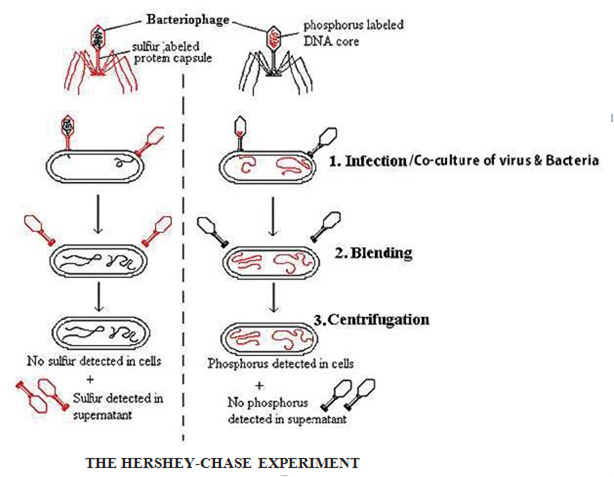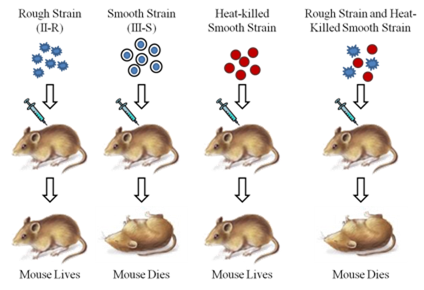Each of the following question(s)/statement(s) has four suggested answers. Choose the correct option in each case.
Transcription is the transfer of genetic code from a DNA molecule to:
RNA molecule
Second DNA molecule
Ribosomal sub unit
Ribosomal sub unit
A.
RNA molecule
Give reasons for the following:
Genetic code is ‘universal’.
The genetic code is called a universal code because all known organisms use the same four nucleotide bases; organism differ according to the arrangement of the nucleotide bases. The four nucleotide bases are adenosine, thymidine, cytidine and guanosine. Three bases form an amino acid, also known as a codon.
Give a brief answer for each of the following:
What are introns?
Introns are the non-coding segments of eukaryotic chromosomes that are spliced out before the RNA molecule is translated into a protein
(a) How did Hershey and Chase prove that DNA is the genetic material?
(b) Give one main application of each of the following:
(i) MRI
(ii) Ultrasound
(iii) ECG
(c) Explain the role of stem cells in medical treatment.
a.
(a) Hershey and Chase conducted experiment on T2 phage, a parasite on common bacterium Escherichia coli. Some T2 phages were grown in cultures of bacteria containing radioactive S(35), whereas remaining T2 phages were grown in cultures of bacteria containing radioactive P(32). S35 was incorporated in the protein coat whereas P32 was incorporated in the DNA of T2 phage. These two types of radioactive phages were made to infect Escherichia coli in two separate samples.
The phages grown in S35 did not transmit their radioactivity to their daughter phages. Whereas the phages P32 pass their radioactivity to the daughter phage particle.
This proved that only DNA was passed on from one generation of T2 to the next.
(i) MRI :
In the examination of brain and spinal cord musculo skeletal disorders, blood flow. In the examination of cancerous bone, pelvic, urinary bladder, joints, vertebral column and cancerous growth in liver and kidney, heart and brain strokes.
(ii) Ultrasound is used in the diagnosis of kidney and gall bladder stones, liver diseases, diseases of ovaries, uterus, etc.
(iii) ECG to anayse the rate and rhythm of atria and ventricles and hence the condition of cardiac muscles of different chambers of heart
(c) Role of stem cells in medical treatment: treatment of genetic disorders/blood cancers.
(a) Describe the experiment performed by Griffith. What conclusions did he infer from his observations?
(b) What is artificial insemination? Mention two ways in which it is useful in breeding of dairy animals.
(c) What is single cell protein? Give its source and significance.
Grifith's experiment
They used Streptococcus pneumonia for the experiment. The bacteria occurs in two forms: smooth virulent strains and rough non-virulent forms.
They injected the mouse with the two strains and found out
When Live R Strain (non virulent bacteria) was injected in mice, the mice remained healthy.
When Live S Strain (virulent variety ) was injected into mice- the mice developed pneumonia and died.
They then killed the virulent strain by heating. When these were injected into mice, they did not develop pneumonia symptoms.
But when a mixture of Live R Strain & Killed S Strain was injected; the mice developed pneumonia and died.
They bacteria isolated from these dead mice were found to contain a mixture of live virulent and non-virulent forms. Live S strain recovered
Thus they concluded that the heat killed virulent bacteria have introduced some transforming principle/factor that has caused some non-virulent bacteria into virulent, capsulated form. This was described as Griffith effect or bacterial transformation. Later, DNA was found to be the transforming (genetic) principle that transformed R cells into live S cells. 
(b) Artificial insemination: The semen of the chosen male is collected and injected into the reproductive tract of the selected female by the breeder.
Importance in breeding of dairy animals:
Semen of healthy males can be used to inseminate a number of females.
Spread of diseases can be controlled and helps to improve a particular breed.
(c) SCP – single cell protein: Any microbial biomass/multicellular bacteria, yeast, fungi, algae which can be used as food
Source: Cyanobacteria such as spirulina / bacteria-Methyliphilus methylotrophus, filamentous fungi – Fusarium graminearum, Trichosporon cutaneum (fungus)/ bacteria
Significance:
i. Can be used as a protein rich supplement in the human diet.
ii. Helps to bridge the gap between demand and supply of protein for human diet and reduces the pressure on agriculture.
iii. Use of organic wastes and industrial effluents in raising SCP will reduce environmental pollution. Absence of pathogenicity & toxicity
